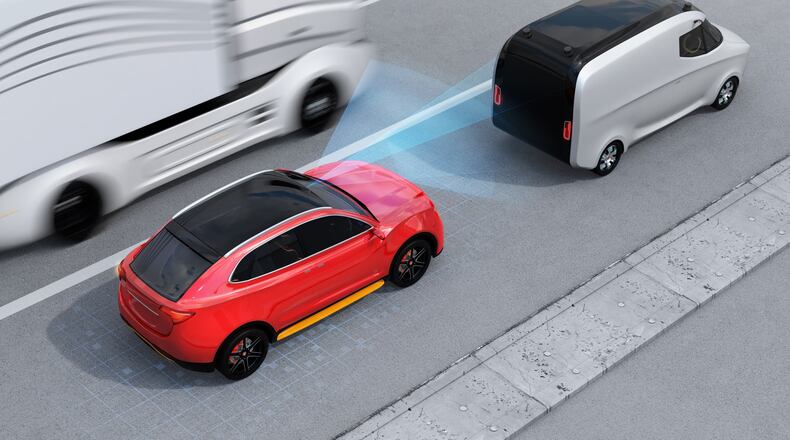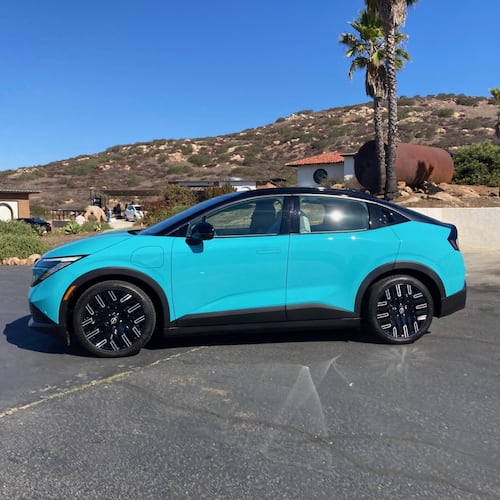Most drivers let several years pass before shopping for a new car. While shoppers aren’t kicking tires at dealerships, significant developments can emerge from the automotive technology landscape. Sure, larger infotainment screens and crisper backup cameras are nice, but advanced safety features — primarily automatic emergency braking — are the most important innovations to look for in your next car.
Automatic emergency braking, sometimes called “forward emergency braking,” is an advanced driver-assistance system that uses sensors to detect potential collisions and automatically applies the brakes to prevent or mitigate an impact. AEB isn’t like an autopilot system on a plane and can’t replace a human, but it is like having extra eyes on the road, always ready to react by slowing or stopping the vehicle if the driver doesn’t respond in time.
Evolution of automatic emergency braking
AEB technology has been available since the mid-2000s but was limited to some pricey luxury models. Thanks to a 2016 voluntary agreement between the National Highway Traffic Safety Administration and 20 automakers, about 90% of new cars built since 2022 have a version of the system available. Even the lowest-priced cars for the 2024 model year, the Nissan Versa and Mitsubishi Mirage, come with AEB systems as standard equipment.
Credit: SPECIAL
Credit: SPECIAL
Earlier this year, the U.S. government created a rule requiring automatic emergency braking systems in all new automobiles beginning in 2029. NHTSA says the rule “will save at least 360 lives a year and prevent at least 24,000 injuries annually.”
Automatic braking system benefits
Forward emergency braking makes driving safer.
In 2022, a coalition of automakers and NHTSA studied data from approximately 47 million automobiles. The group found the combination of AEB and forward collision warning reduced collisions by about half. The vehicles from model years 2015 to 2020 with such systems had 49% fewer front-to-back crashes than those without.
Similarly, another study found a 43% reduction in crashes with AEB-equipped pickup trucks rear-ending other vehicles. This 2022 Insurance Institute for Highway Safety analysis examined police-reported crashes from 25 states for 2017-2020.
Having improved safety means, in some cases, vehicles equipped with AEB may qualify for lower insurance premiums thanks to their reduced risk of accidents.
How AEB works
Many drivers might not know about forward collision prevention systems. After all, not every shopper buys a new car; some buyers might stay in their current vehicles for a decade before looking for newer models. According to a report from S&P Global Mobility, the average age of cars and light trucks on the road in 2024 is 12.6 years.
So, how does automatic emergency braking work? The system relies on sensors, including radar, cameras, and sometimes lidar (light detection and ranging), to monitor the road ahead. Here’s a step-by-step breakdown:
Detect: The system’s components, mounted in the bumper, grille and behind the windshield, continuously scan for obstacles, such as vehicles, pedestrians or animals.
Assess: The system assesses potential collisions by calculating factors like distance, speed and trajectory of the car and obstacles.
Warn: The AEB may provide a visual, audible or haptic warning to alert the driver to imminent danger and urge them to act.
Brake: If the driver doesn’t respond in time, the system engages the brakes, either partially or fully, to avoid the collision or reduce its impact.
AEB is not a substitute for attentive driving
It is crucial to stay alert and pay attention when driving, regardless of the technological safety systems in place.
Forward collision prevention systems don’t always work as advertised. They cannot detect every potential obstacle or avoid those suddenly appearing in the car’s path.
Some AEB systems are optimized for lower speeds and aren’t as effective at highway speeds. Inclement weather can reduce the performance of the system’s sensors. Some testing from the IIHS showed automatic braking systems don’t work as well in the dark as they do in the daylight. However, the technology will continue to improve.
AEB and other safety features assist but do not replace the human element of driving. Ultimately, the driver is responsible for the safe operation of the vehicle. AEB is a safety net.
Make informed decisions
Evaluate safety features when shopping for a new vehicle or a new-to-you used car. AEB is a valuable addition, but it’s often just part of a comprehensive safety suite in most newer models. Look for vehicles combining AEB with other advanced driver-assistance systems.
Adaptive cruise control maintains a set speed while automatically adjusting the vehicle’s speed to keep a safe distance from the car ahead. It works well with AEB to manage speed and prevent collisions.
Added to AEB and cruise control, lane monitoring features help keep the vehicle between the lines to prevent side collisions.
Lane Departure Warning alerts the driver if the vehicle begins to drift out of its lane without activating the turn signal.
Lane-Keeping Assist is a reactionary function that can gently steer the car to nudge it back into its lane.
Lane-Centering Assist proactively steers the car to keep it centered in the lane instead of waiting for it to drift toward the lane markings.
Blind spot Monitoring uses sensors to detect vehicles in the car’s blind spots and alert the driver with visual or audible signals.
Automatic emergency braking is a significant contributor to automotive safety. It offers enhanced protection, peace of mind and potential savings from property damage and insurance costs. Look for this feature in your next car. However, there is no substitute for staying attentive and alert in the driver’s seat to stay safe on the road.
Chris Hardesty is a veteran news researcher and editor who provides advice on buying, owning and selling cars for Kelley Blue Book and Autotrader.
The Steering Column is a weekly consumer auto column from Cox Automotive. Cox Automotive and The Atlanta Journal-Constitution are owned by parent company, Atlanta-based Cox Enterprises.
About the Author
Keep Reading
The Latest
Featured


